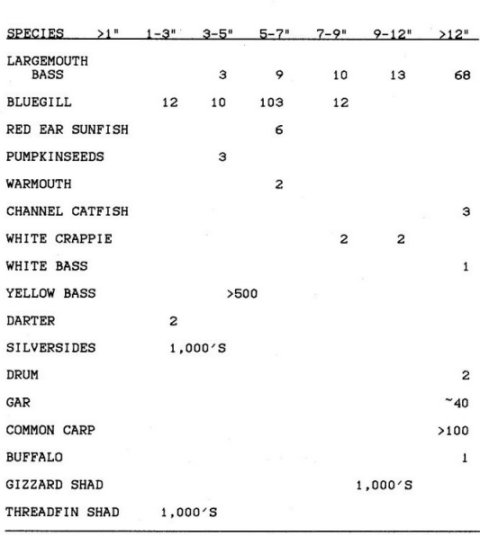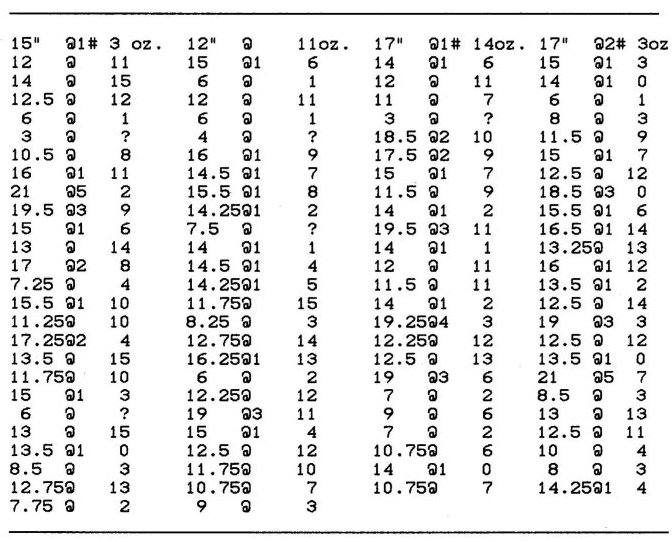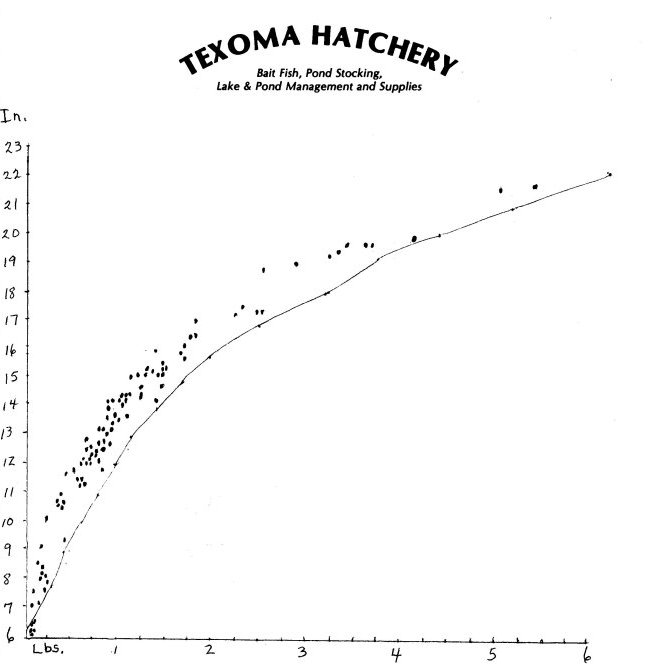
1995 Lake Vilbig Survey By Bob Lusk of Texoma Hatchery
The following information was taken from a presentation created by Bob Lusk. The documents were scanned in using a photo scanner and OCR (optical character recognition) scanner software.
TEXOMA HATCHERY
March 22, 1995
Vilbig Bass Club
Lake Vilbig Property Owners Association
141.3 Lakeshore Dr.
Irving, Tx, 75060
Greetings!
From the world headquarters of Texoma Hatchery Just outside Dixie, Texas, we want to say, "Thank you" for the opportunity to evaluate your lake.
You have a very interesting lake and environment. The evaluation found some very intriguing evidence.
First of all, the environment. It is my understanding that you are continuing to closely monitor water quality. Keep up the good work. Keep dates, parameters, and consistent sampling. Hopefully you won't need it, but you are gathering evidence, always a prudent thing to do. Add to your list of good news—there is biological evidence today that you have a stable, clean environment. We found two animals that can only exist in a consistent, nontoxic environment. You have grass shrimp, a small (no larger than 2-2 1/2 inches) clear shrimp, and small darters, maybe 3 inches long. Neither of these animals can thrive in dirty water. Good news. They are native animals to watersheds across Texas, so they are in your lake naturally.
We electrofished the lake, gathered many fish (see table), and have conclusions to share with you. Marty and Paul took seine samples from 5 locations around the lake, gathering another group of fish. David, Walter, and I set two gill nets and gathered even more data about your fishery. The following report is a summary of this data, with conclusions and recommendations. First, let's look at the different species and sizes of your fish. It was a very Interesting sample.

The following table is a grouping of lengths and weights of the largemouth bass, the fish you are most interested in improving

On a separate page is a graph that shows the relationship between the lengths and weights of your bass to fish that are of a "normal" measurement. These normals have been gathered from thousands of fish over many years and are considered a standard for Texas largemouth bass. What we see is that your bass are slightly underweight. There are several reasons. First of all, there is a large amount of competition for the right size food for a particular size range of fish. The yellow bass are the main predator of very small fish. Small fish get eaten, they can't grow Into the best forage for larger bass, 10-12". Gar are predatory as are white bass and crappie. The crappie appear to not be overcrowded with small fish. Continue your harvest plan, it's working. The average size crappie are large. The yellow bass are your main competitor, but they are also a source of food for bass. We "examined" the stomach contents of one large bass and he had a yellow bass and crawfish in his stomach.
The majority of your forage fish are too large for the predominant sizes of bass to feed on. You have too many large gizzard shad. The big bass can eat them, but the intermediate ones cannot. There are too few bluegills, most of them in the 5-7" range.
Here is a summary of the findings:
1) Too many bass in the 11-15" range. Recommendation: harvest fish inside this "slot", release those outside it.
2) There are not enough bluegill, the backbone of largemouth bass food chains. Stock coppernose bluegill to
enhance the bass food chain. 4-5" are large enough for your fishery, if done in the spring. Cost for 5,000 would be
$.40 each, 10,000 would be .38 each.
3) Too many large shad. Harvest and remove large gizzard shad. Gill nets work very well, or we may be able to harvest some and sell them for you. We can talk about that later.
4) Insufficient feed for fish. Consider recommending some homeowners begin feeding off their docks. A commercial floating fish food would be the ticket.
5) Too many carp and gar. Consider having one or two "carp tournaments" each year, with prizes or bounties.
In summary, you have a very healthy, active lake. Be proud and protect what you have. Several simple management strategies will enhance the fishery. Big bass are just a matter of time, especially since you added bass with Florida genetics. You likely have a few bass approaching 8 pounds, but be patient. I expect, with just a little management that you will produce some bass that will draw attention in just 3 or 4 years. Bass in the 10 pound class are just a matter of time.
Continue your catch records, with both lengths and weights. This is the best way to monitor growth and the movement of the population as a whole. That is the best way to monitor the results of what you are doing.
If you have any questions, please call. I will be glad to continue as a consultant to your project. If you nee a presentation to the board or any other communications, please advise. In the meantime, have fun, and like Willie Landem says, "keep a tight line".
Thanks again for your business.
Sincerely,
Bob Lusk
Route 2, Box 506 * Whitesboro, Texas 76273 * 903 / 564-5372

Bass Eating a Bluegill
Paul Miles and David Kern
Carp
Paul Miles, David Kern, and Marty Tackett
Marty Tackett, David Kern, and Paul Miles
Paul holding up some crappie
___________________________________________________________________________________